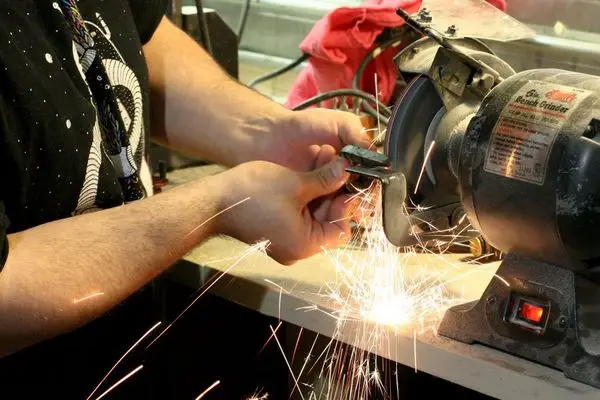- You are here:
- Home »
- Blog »
- Grinding Tips
- » Can You Slow Down a Bench Grinder?

Can You Slow Down a Bench Grinder?
Bench grinders are fantastic tools. The latest and most expensive bench grinders come with variable speed settings. But perhaps like me, you have an older model and would like to be able to lower the speed on your existing bench grinder, so that you can sharpen the blades of your tool collection more precisely.
How do you slow down a bench grinder? There are several effective ways of reducing the speed on a bench grinder, for example: controlling the router speed, fitting a belt pulley, using a variable frequency drive, reducing the wheel size and even building your own slow speed grinder.
In this article, I will discuss each of these different methods of slowing down your bench grinder and then you can decide which is the most suitable for your purposes.
Bench Grinder Speed

A bench grinder is a tool which spins grindstones, and these grindstones gently shape metal. They can quickly sharpen blunt tools. Most bench grinders run at about 3,450 rpm, although there are more and more variable speed grinders on the market these days.
If you’re careful and keep the wheel dressed, a high speed grinder will work fine for you. However, for sharpening blades, a low-speed grinder running at 1,750 rpm is a much better choice. A lower speed reduces the chance of the edge of your tool overheating.
Slow Speed Bench Grinders
Slow speed grinders do still generate heat, but it happens at a more controllable pace that is ideal for work on delicate metals. This is what is required for sharpening work because the edges of cutting tools are very thin and can overheat easily. With a slow speed grinder and some practice you can learn to sharpen just about any cutting tool without ruining the hardness of the blades.
Slow speed grinders tend to cost a bit more because they need better motors. Slow motors need to have more power and torque to overcome lower inertia and possible stalling during the grinding process. If you have a grinder already and don’t wish to make an expensive purchase, you can rest assured that there are many ways of slowing down your existing grinder.
Slowing Down Your Bench Grinder
There are many ways to slow down your bench grinder, these include:
• Router Speed Control
• Fitting a belt Pulley
• Using a Variable Frequency Drive
I will discuss each of these methods of slowing down your bench grinder.
Router Speed Control
If the motor on your bench grinder is under 1HP you should be able to control the speed with a router speed control. My experience with this kind of set-up,however, is that when the speed is lowered, it loses its steady rhythm and jerks between 90 and 110 RPM
Fitting a Belt Pulley
You can slow down your bench grinder by fitting a belt pulley in the place of the wheel. You can then fir a V belt to a secondary shaft with a larger pulley wheel. The gear ratio would then be: diameter small pulley/diameter large pulley.
Using a Variable Frequency Drive (VFD)
By running the motor through a variable rheostat control, you will reducing the voltage to the motor. In order to make up for the reduced voltage, the motor will demand more amps. This will cause the motor to run hotter.
The correct way to do this is with a VFD (variable frequency drive). This will change the 60 cycle frequency that the motor runs on and make the motor a variable speed motor without changing the voltage or the amperage. There are plenty of VFDs available which convert 120V 1 phase to 220V 3 phase.
The down side of this is that when you slow it down with a VFD, the motor loses torque at the same time. This means that the grinder is easier to stall. VFDs aren't as expensive as they used to be, but probably more than you want to spend on a low end bench grinder. This is the safest and most reliable way of slowing down your bench grinder.
Reducing wheel size to slow down grinder speed
Generally speaking, the smaller the wheel size, the slower the grinder speed. So as your grinding wheel wears down, it will also slow down. The thickness of the wheels is also significant. Thicker wheels last longer and cut more slowly generating more friction and heat. The downside of this. Is that the thicker discs often result in the workpiece becoming discoloured.
DIY Slow Speed Grinder

To make a slow speed grinder, you will need a mandrel. A mandrel consists of a basic shaft, which is threaded on both end to make arbors, two pillow block bearings, and a pulley.
I used a second pulley of the same diameter for the motor itself, making the grinding wheel RPM 1725 too. I mounted two 6" X 1-1/2" aluminum-oxide grinding wheels to the arbors and now I have a slow speed grinder that I made myself.
Bench Grinder Safety
It is important to remember that whenever you use a bench grinders, or any domestic tools, great care is required. Bench Grinders are powerful motorized spinning tools which should always be used exactly as directed by the manufacturer.
The user should make sure that they have taken great care to read the instructions before setting up and using the bench grinder. It is also important that the user takes care to wear appropriate safety gear including: hats, gloves, eye protection, hearing protection and spark resistant clothing.
Conclusion
You might have decided that a grinders a great asset to your tool shed, if this is the case, it is worth investing in a grinder that can work at a slower speed. If you already have a grinder that only works at higher speeds, there are a number of ways of slowing the speed.
The most successful of these methods is to use a variable frequency drive which will reduce the voltage and force the grinder to work at a much slower speed.

